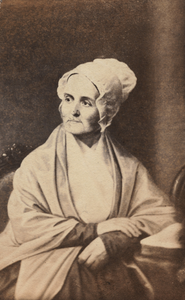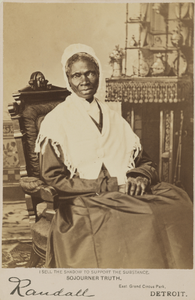Unidentified Artist
Description
Twenty-two years senior to Elizabeth Cady Stanton, Lucretia Coffin Mott was the elder stateswoman of of women's rights and although not a suffragist, she inspired many. Before the movement for women’s rights gained traction, Mott enjoyed universal respect within the U.S. abolition movement for her frugal and moral lifestyle. For Mott, clothing was a public manifestation of her religious and social beliefs. In addition to wearing the Quaker cap, as in this photograph, she often sewed her own garments using fabric that she sourced carefully to avoid using material produced through slave labor.At the first World Anti-Slavery Convention in London, in 1840, antislavery leaders denied Mott and other women delegates full participation by relegating them to seats in the back of the room. Elizabeth Cady Stanton, who was attending the meeting with her husband, moved to sit with the women delegates in an effort to strengthen their solidarity. Experiences like this sparked the conversation about women’s rights.Lucretia Coffin Mott, quien le llevaba 22 años a Elizabeth Cady Stanton, era la veterana entre las líderes sufragistas. Antes de que el movimiento femenino tomara impulso, ya Mott era respetada dentro del movimiento abolicionista por su moral y su frugalidad. Su vestuario era la manifestación pública de sus creencias religiosas y sociales. Además de llevar la cofia cuáquera, como en esta foto, solía coserse sus propios trajes con telas que escogía con cuidado, evitando materiales producidos por labor esclava.Durante la primera Convención Mundial Antiesclavista en Londres, en 1840, los dirigentes negaron plena participación...
Image
Albumen Silver Print
National Portrait Gallery, Smithsonian Institution; gift of Frederick M. Rock
Record Contributed By
National Portrait GalleryRecord Harvested From
Smithsonian InstitutionKeywords
- Abolitionist
- Abolitionists
- Carte De Visite
- Clergy
- Costume
- Education
- Educator
- Educators
- Female
- Feminist
- Hat
- Hats
- Headgear
- Lecturer
- Lucretia Coffin Mott
- Minister
- Mott, Lucretia Coffin
- Photographic Format
- Portrait
- Portraits
- Reformer
- Reformers
- Religion And Spirituality
- Social Reformer
- Society And Social Change
- Suffragist
- Teacher
- Women
- Women's Rights Advocate





















